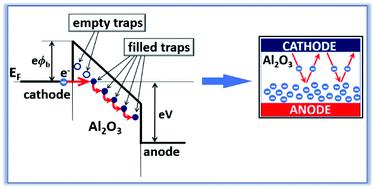Our official English website, www.x-mol.net, welcomes your
feedback! (Note: you will need to create a separate account there.)
Coulomb barrier creation by means of electronic field emission in nanolayer capacitors.
Nanoscale ( IF 5.8 ) Pub Date : 2020-08-26 , DOI: 10.1039/d0nr04660d Eduard Ilin 1 , Irina Burkova , Timothy Draher , Eugene V Colla , Alfred Hübler , Alexey Bezryadin
Nanoscale ( IF 5.8 ) Pub Date : 2020-08-26 , DOI: 10.1039/d0nr04660d Eduard Ilin 1 , Irina Burkova , Timothy Draher , Eugene V Colla , Alfred Hübler , Alexey Bezryadin
Affiliation

|
The main mechanism of energy loss in capacitors with nanoscale dielectric films is leakage currents. Using the example of Al–Al2O3–Al, we show that there are two main contributions, namely the cold field emission effect and the hopping conductivity through the dielectric. Our main finding is that an application of a high electric field, ∼0.6–0.7 GV m−1, causes electrons to penetrate the dielectric. If the temperature is sufficiently low, such electrons become permanently trapped in the dielectric. To achieve a strong charging of the dielectric, the voltage needs to be high enough, so that a field emission occurs from the cathode into the dielectric. Such a strongly charged dielectric layer generates a Coulomb barrier and leads to a suppression of the leakage current. Thus, after the dielectric nanolayer of the capacitor is charged, the field emission and the hopping conductivity are both suppressed, and the hysteresis of the I–V curve disappears. The phenomenon is observed at temperatures up to ∼225 K. It would be advantageous to identify insulators in which the phenomenon of the Coulomb barriers persists even up to the room temperature, but at this time it is not known whether such dielectrics exist and/or can be designed.
中文翻译:

通过纳米层电容器中的电场发射产生库仑势垒。
具有纳米级介电膜的电容器中能量损失的主要机理是泄漏电流。以Al–Al 2 O 3 –Al为例,我们表明有两个主要贡献,即冷场发射效应和通过电介质的跳跃电导率。我们的主要发现是施加约0.6–0.7 GV m -1的高电场导致电子穿透电介质。如果温度足够低,则这些电子将永久地捕获在电介质中。为了实现电介质的强充电,电压必须足够高,以便从阴极到电介质发生场发射。这种强充电的介电层产生库仑势垒并导致泄漏电流的抑制。因此,电容器的电介质纳米层被充电之后,场致发射和跳频电导率都抑制,并且的滞后我- V曲线消失。在高达约225 K的温度下观察到该现象。识别绝缘材料时,即使在室温下仍可保持库仑势垒现象,这是有利的,但目前尚不知道这种电介质是否存在和/或可以设计。
更新日期:2020-09-24
中文翻译:

通过纳米层电容器中的电场发射产生库仑势垒。
具有纳米级介电膜的电容器中能量损失的主要机理是泄漏电流。以Al–Al 2 O 3 –Al为例,我们表明有两个主要贡献,即冷场发射效应和通过电介质的跳跃电导率。我们的主要发现是施加约0.6–0.7 GV m -1的高电场导致电子穿透电介质。如果温度足够低,则这些电子将永久地捕获在电介质中。为了实现电介质的强充电,电压必须足够高,以便从阴极到电介质发生场发射。这种强充电的介电层产生库仑势垒并导致泄漏电流的抑制。因此,电容器的电介质纳米层被充电之后,场致发射和跳频电导率都抑制,并且的滞后我- V曲线消失。在高达约225 K的温度下观察到该现象。识别绝缘材料时,即使在室温下仍可保持库仑势垒现象,这是有利的,但目前尚不知道这种电介质是否存在和/或可以设计。











































 京公网安备 11010802027423号
京公网安备 11010802027423号